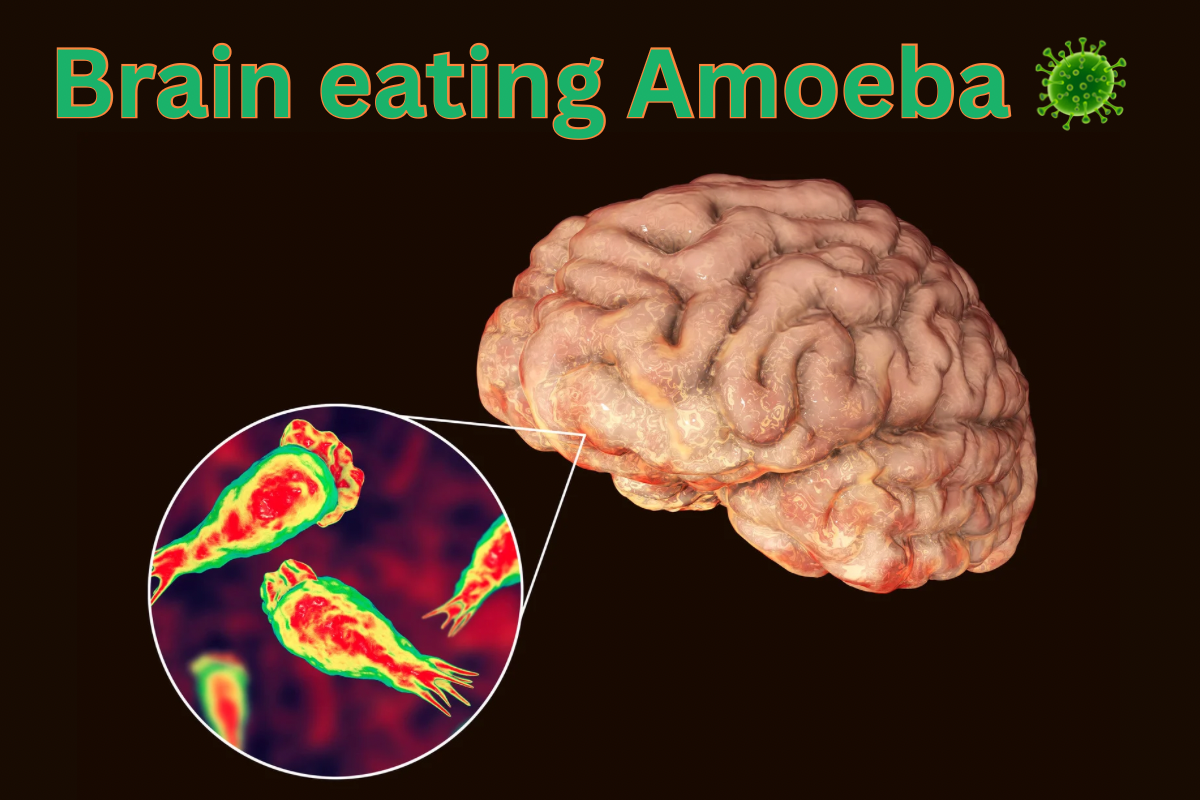Deadly Brain-Eating Amoeba: What You Need to Know
Deadly Brain-Eating Amoeba: What You Need to Know The Naegleria fowleri, commonly known as the brain-eating amoeba, is a rare but often fatal cause of brain infection.
This microscopic parasite is typically found in warm freshwater environments, posing a risk to individuals engaging in water activities.

Understanding the risks associated with Naegleria fowleri and taking necessary precautions can help minimize the danger.
The Centers for Disease Control and Prevention (CDC) provides valuable information on the risks and prevention strategies.
Key Takeaways – Deadly Brain-Eating Amoeba: What You Need to Know
- Naegleria fowleri is a rare cause of brain infection.
- Understanding the risks can help minimize the danger.
- The CDC provides information on risks and prevention strategies.
Understanding the Brain-Eating Amoeba
Naegleria fowleri, commonly referred to as the brain-eating amoeba, is a microscopic organism found in warm, freshwater environments.
What Is Naegleria Fowleri?
Naegleria fowleri is a single-celled organism that thrives in warm temperatures. It is typically found in freshwater lakes, rivers, and hot springs. When people come into contact with contaminated water, they may be at risk of infection. The amoeba migrates to the brain, causing a severe and often fatal infection known as primary amebic meningoencephalitis (PAM).
Natural Habitats and Environmental Conditions
The growth of Naegleria fowleri is supported by warm temperatures and low water levels. Environmental conditions such as these can contribute to the amoeba’s presence in freshwater bodies. The table below summarizes the ideal conditions for Naegleria fowleri growth.
| Environmental Factor | Ideal Condition for Naegleria Fowleri |
|---|---|
| Water Temperature | Warm to hot temperatures (above 80°F) |
| Water Level | Low water levels |
| Water Type | Freshwater |
How Brain-Eating Amoeba Infections Spread
When individuals engage in water in water activities in contaminated contaminated freshwater environments, they risk exposure to brain-eating amo a amoeba infections.
Transmission Routes
- Swimming or diving in contaminated water in contaminated water
- Submerging one’s head in infected water
These activities increase the risk of exposure to brain-eating amo a amoeba. The amoeba enters the body through the nasal passages, eventually reaching the brain and causing severe damage.

High-Risk Activities and Locations
Participating in water in water sports or recreations that involve nasal exposure to contaminated water increases the risk of infection.
Locations with warm, stagnant,>, or slow-moving water> water are more likely to harbor Naegleria fowleri/em>.
Awareness of these risks risks and taking preventive measures can significantly reduce the likelihood of infection.
Recognizing Brain-Eating Amoeba Infections
Recognizing the signs and symptoms of Naegleria fowleri infection is vital for timely medical intervention.
The initial symptoms can be nonspecific, making early diagnosis challenging.
Early Warning Signs and Symptoms
Early symptoms of brain-eating amoeba infection may include headache, fever, nausea, and vomiting.
These symptoms are often similar to those of other common conditions, making it crucial to consider recent exposure history.
Disease Progression Timeline
As the disease progresses, symptoms can escalate to include confusion, seizures, and loss of consciousness.
The progression from initial symptoms to severe neurological manifestations can occur rapidly, often within a few days.
Medical Diagnosis Challenges
Diagnosing Naegleria fowleri infection poses significant challenges due to its rarity and similarity to other neurological conditions.
A high index of suspicion and prompt laboratory testing are essential for diagnosis.
| Symptom | Early Stage | Late Stage |
|---|---|---|
| Headache | Present | Severe |
| Fever | Present | High |
| Neurological Symptoms | Absent | Confusion, Seizures |
Protecting Yourself from Brain-Eating Amoeba
The risk of brain-eating amoeba infection can be significantly reduced by adopting simple yet effective prevention strategies.
By understanding the risks and taking appropriate precautions, individuals can enjoy water activities with greater safety.
Effective Prevention Strategies
One of the most effective ways to prevent brain-eating amoeba infections is to avoid nasal exposure to contaminated water.
Using nose clips or holding your nose shut when swimming in warm freshwater lakes or rivers can significantly reduce the risk.
Additionally, avoiding high-risk activities such as diving or jumping into potentially contaminated water can further minimize the risk of infection.
Treatment Options and Survival Rates
Despite the low incidence of brain-eating amoeba infections, understanding the treatment options is crucial.
| Treatment Component | Description | Effectiveness |
|---|---|---|
| Antifungal Medications | Target fungal infections | Moderate |
| Antimicrobial Medications | Combat microbial infections | High |
| Combination Therapy | Combination of antifungal and antimicrobial treatments | Variable |
Staying informed about the risks and taking preventive measures can significantly reduce the risk of infection.
By adopting these strategies, individuals can protect themselves from the potentially deadly consequences of brain-eating amoeba infections.
Conclusion: Staying Safe While Enjoying Water Activities
While the risk of brain-eating amoeba infection is rare, being aware of the risks and taking necessary precautions can help you stay safe while enjoying water activities.
By adopting simple preventive measures such as using nose clips and avoiding nasal exposure to potentially contaminated water, you can minimize your risk.
This way, you can enjoy your favorite water activities with peace of mind, ensuring your safety from brain eating amoeba.
Staying informed and taking the right precautions can go a long way in ensuring your safety during water activities.
So, be aware, be safe, and enjoy your time in the water.
FAQ
How does Naegleria fowleri infection occur?
Infection occurs when contaminated water enters the nasal passages, allowing the amoeba to migrate to the brain, causing a severe and often fatal infection.
How can I protect myself from brain-eating amoeba infections?
You can protect yourself by avoiding nasal exposure to potentially contaminated water, using nose clips, or holding your nose shut when engaging in water activities.
What are the treatment options for Naegleria fowleri infections?
Treatment involves a combination of antifungal and antimicrobial medications, although the survival rate remains low, emphasizing the importance of prevention.
Are there any high-risk activities or locations that I should be aware of?
Yes, high-risk activities include water sports and recreations that involve nasal exposure to contaminated water, and locations with warm, stagnant, or slow-moving water are more likely to harbor Naegleria fowleri.
How can I minimize my risk of brain-eating amoeba infection while enjoying water activities?
By understanding the risks, adopting preventive measures, and staying informed, you can minimize your risk and enjoy water activities with peace of mind.

Dr. Shabbir Hussain Bohra (Physio)
Owner & Founder – Physio Talk
Director – HAKIMI Physiotherapy Clinic, Nagpur
Dr. Shabbir Hussain Bohra is a dedicated physiotherapist with seven years of comprehensive experience in rehabilitation and specialized therapeutic care. He holds a Bachelor of Physiotherapy (BPT) degree and has established himself as a leading expert in oncology physiotherapy and lymphedema management. Currently serving as a Consultant Physiotherapist at Asian Kidney Hospital, Nagpur, director hakimi Physiotherapy clinic nagpur Dr. Bohra brings extensive expertise in treating complex medical conditions requiring specialized rehabilitation approaches. His dual specialization as an Onco-Physiotherapist and Lymphedema Therapist enables him to provide targeted care for cancer patients and individuals managing lymphatic disorders.
